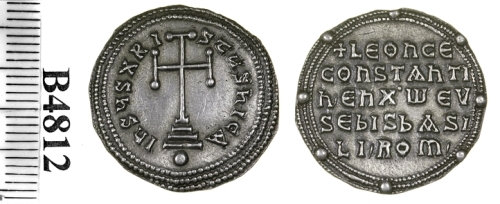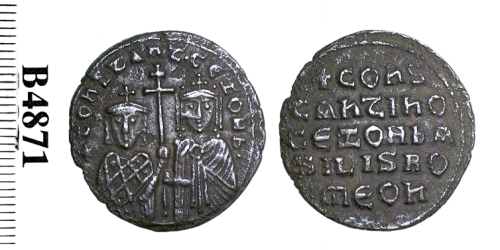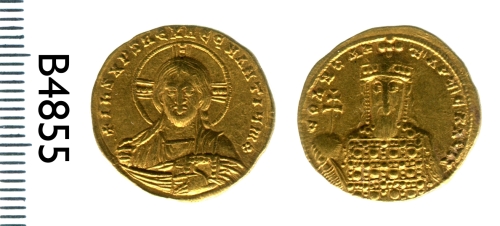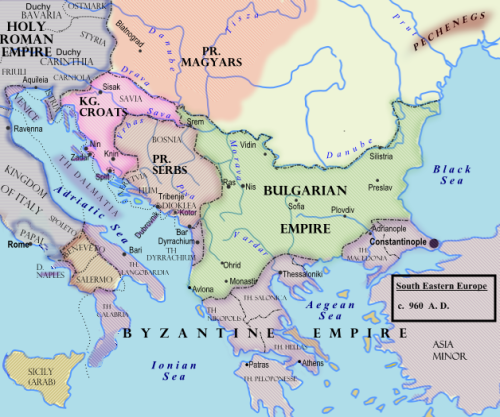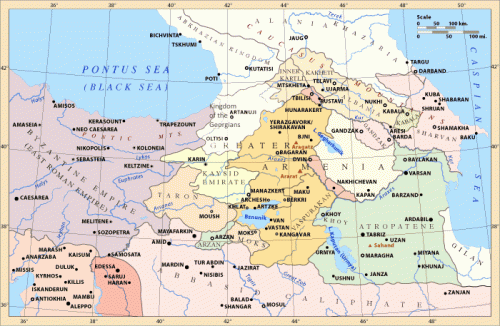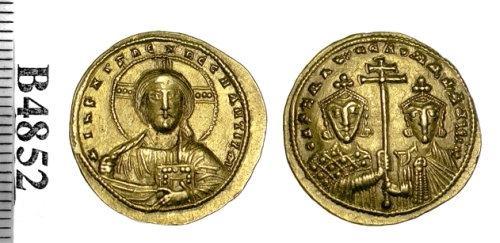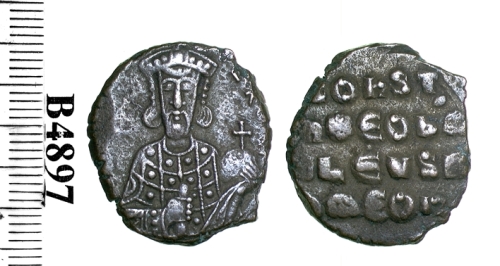
Ivory depiction of Constantine VII being crowned by Christ, now in the Pushkin Museum, Moscow, image from Wikimedia Commons
Let me return for one last post—for now, at least—to the De Administrando Imperio of Emperor Constantine Porphyrogenitus (913-959).1 I’ve described already how rambling and personal this text can be as one gets closer to Constantine’s own recollections, and how sharply tuned to its purpose it can be beneath that exterior when one presses. At times, the two things coincide, and this is sharpest of all in the sections that cover the disputed and often-autonomous territories at the east end of what is now Turkey heading into the Caucasus, what is now Armenia, Georgia and Azerbaijan and was then Armenia, Lazica, Iberia and a number of other small polities whose number scholars in Baghdad, at least, considered impossible to count.2 These were areas where by the tenth century, after a long period of stand-off diplomacy, the Byzantine Empire had found it more and more possible to take a direct military interest, which was as Constantine wrote unbalancing local power relations left, right and centre.3 Imperial intervention for one side or another regularly increased the local instability, and it is in this section of the De Administrando Imperio that one really sees how it was done. This was where the kind of mind Constantine had, which could track tiny details of interpersonal relations for dozens of people and work out where a well-aimed gift or sanction would split them out, was exactly the right tool for the job, and having the statecrafter himself to tell you about it is really illuminating.

Map of Armenia and its neighbours in the early- to mid-tenth century. By www.armenica.org – www.armenica.org, GFDL, https://commons.wikimedia.org/w/index.php?curid=12515076
We begin in the middle of an account “of the country of Taron”, which in the time of Constantine’s father Leo VI was ruled by one Krikorikios (Grigor, or, as we might put it, Gregory).4 Krikorikios was essentially a vassal of the Sultan of Baghdad at this point, but was also contending for the rule of Taron with his cousin Ashot Arkaïkas, and at an uncertain point he managed to capture Ashot’s sons in battle. Ashot wrote for help to Sembat, Prince of Princes of Armenia, and Sembat wrote for help to Emperor Leo. Leo sent a couple of embassies, and with the second one, led by one Constantine Libos, brought Krikorikios’s brother Apoganem (or Abu Ghanim, it’s mixed-up out here) and the two prisoners to Constantinople, honoured Apoganem with the imperial rank of protospatharios and got to keep the kids at the capital. This is where we enter the story:
“After this the said Constantine spent some time in Chaldia, and was then commissioned by imperial mandate to go to Taron and take Krikorikios, prince of Taron, and come to the imperial city; and this he did. When this same Krikorikios had entered the city protected of God, and had been honoured with the rank of magister and military governor of Taron, he was also given for his residence a house called the house of Barbaros, now the house of Basil the chamberlain. He was, moreover, honoured with an annual stipend of ten pounds in gold and a further ten pounds in miliaresia, making twenty pounds in all. After some sojourn in the imperial city, he was escorted back again to his country by this same protospatharius Constantine.
This weighs two-and-a-half grams, so ten pounds of them would pile up a bit… Silver miliaresion of Emperors Leo VI and Constantine VII, struck at Constantinople between 908 and 912, Barber Institute of Fine Arts B4812
“After this, Apoganem came once more to the emperor, of blessed memory, and was advanced by him to the rank of patrician; and he was also permitted to take to wife the daughter of the said Constantine; and on this ground he asked for a house as well and he too received the house of Barbaros, without a golden bull. After receiving the emperor’s bounty, he then returned to his country, with intent to come again and complete the celebration of his marriage; but no sooner was he escorted back to his country than he ended his life, a few days afterwards. His brother Krikorikios sent letters asking that he might come to the imperial city and receive from the hands of the holy emperor the stipend granted to him and sojourn for some while in the city protected of God. Thereupon he proceeded to demand for his residence the house which had been set aside for his brother, and the emperor, of blessed memory, handed it over to him, both because he had lately submitted himself and in order to excite in other princes of the east a similar eagerness for submission to the Romans; but he issued no golden bull making a deed of gift of this house to him.
About three hundred years too late, but, this is one of those golden bulls the text keeps going on about, a chrysobull of Emperor Andronikos II to the church of Monemvasia from 1301 (Athens, Byzantine and Greek Museum BXM534), made of four sheets of parchment glued together
“Several years later, when the emperor Romanos, of blessed memory, had laid hold upon the sceptre of the empire of the Romans, this same Krikorikios reported that he had not the means to keep the house of Barbaros, but demanded that he should receive in its stead a suburban estate in Keltzini, either that of Tatzates or some other, whichever the emperor directed, in order that, when the Agarenes should make an incursion into his country, he might be able to send thither his personal relatives and substance. The emperor, who did not possess an accurate knowledge of the facts, and supposed that the Taronite held the house of Barbaros in virtue of an imperial golden bull of Leo, of blessed memory, gave him the suburban estate of Grigoras in Keltzini and, of course, took back the house; but he too issued no golden bull in favour in respect of the suburban estate.
Modern Erzincan, Turkey, central town of the old province of Keltzini where Krikorikios wanted his estate, a lot further from the capital but within plausible fleeing range of Taron all right
“Thereupon Tornikis, nephew of the Taronite and son of the late Apoganem, wrote to this same emperor:
«The house of Barbaros was presented to my father by the emperor Leo, of most blessed memory, but after my father’s death, because I was under age and an orphan, my uncle, in virtue of his authority, took possession of his house, always promising that when I should come of age, I should take over the paternal house; and now, as I have learned, my uncle has given this house to your imperial majesty, and has received in exchange for it the suburban estate of Grigoras in Keltzini.»
“And because of these imperial gifts bestowed on the prince of Taron, envy towards him was implanted and grew up in Kakikios, prince of Basparaka [Gagik Ardzrouni prince of Vaspurakan], and Adranasir, the curopalate of Iberia, and Asotikios [Ashot Erkot], the prince of princes [of Armenia], who wrote to the emperor grumbling at the cause whereby the Taronite alone enjoyed an imperial stipend, while all of them got nothing.
«For what service – they said – is he performing more than we, or in what does he help the Romans more than we do? Either, therefore, we too should be stipendiary as he is, or else he too should be excluded from this largesse.»
The emperor Romanos, of blessed memory, wrote back to them, that the stipend in favour of the Taronite had not been granted by him, that it should now lie with him to cut it off, but by the emperor Leo, of most blessed memory; nor was it right that what had been done by former emperors should be undone by their successors. However, he wrote to this same Taronite informing him that the said parties were vexed and offended. He replied that he could provide neither gold nor silver, but promised to give, over and above the gifts regularly sent, tunics and bronze vessels up to ten pounds in total value, and these he did give for three or four years. But thereafter he reported that he could not provide this tribute, and demanded either that he should receive the stipend gratis as in the time of the emperor Leo, or else that it should be cut off. And so, that it might not cause offence to Kakikios and the curopalate and the rest, the said emperor Romanus, of blessed memory, cut it off. But to console him, as it were, he afterwards honoured his son Asotios, when he came to Constantinople, with patrician rank and entertained him munificently before sending him home.
“On the death of the magister Krikorikios [in 929], Tornikios [Thornik], son of Apoganem, reported that he heartily desired to come and behold the emperor; whereupon the emperor sent the protospatharius Krinitis, the interpreter, who brought the said Tornikios to Constantinople, and the emperor advanced the same Tornikios to the honour of patrician rank. He put forward his claims to the house of Barbaros, and having heard that his uncle had resigned his ownership of it on receipt of a suburban estate in Keltzini, declared that his uncle had no power to effect an exchange in respect of his paternal inheritance, and demanded that he should be given either the house or the suburban estate, failing which, he was for resigning both to the emperor, so that his cousins might not have them. Therefore the emperor, since the old Taronite was now dead, resumed the suburban estate but did not give the house in exchange for it, because, as has already been stated above, no golden bull had been issued in respect of any of these transactions.
Genealogy of the various princes involved here, taken from Romilly J. H. Jenkins (ed.), Constantine Porphyrogenitus: De Administrando Imperio. A Commentary (London 1962 repr. Washington DC 2012), p. 161
“After this, the late Pankratios, eldest son of that magister Krikorikios the Taronite, came to the imperial city and was advanced by the emperor to the dignity of patrician and was also made military governor of Taron. He asked that he might also be given a wife from among the ladies related to the imperial family, and the emperpr gave him to wife the sister of the magister Theophylact. And after his marriage he made a will, in which he stated: «If children are born to me of this women, they are to have all my country for their ancestral inheritance.» Thereupon he asked the emperor that he might be given the suburban estate of Grigoras for the patrician lady, his wife, to reside there, and after he death this suburban estate should revert to his imperial majesty. The emperor sanctioned this too, and after presenting him with many gifts, sent him with his wife away to his country. Now, the sons of the magister Krikorikios, the same patrician Pankratios and the patrician Asotios, greatly vexed and oppressed their cousin, the patrician Tornikios, who, finding their aggressiveness unendurable, wrote to the emperor to send a trustworthy servant and take over his country, and conduct himself and his wife and their child to the emperor. The emperor sent the protospatharius Krinitis, the interpreter, to take him and conduct himself and his wife and their child to the emperor. But when Krinitis arrived in that country, he found that Tornikios had already departed this life, having devised before his end that all his country should be subject to the emperor of the Romans, and that his wife and child should go to the emperor; and to her, on her arrival, the emperor gave for her residence the monastery in Psomathia of the protospatharius Michael, formerly collector of Chaldia. The said Krinitis was sent back again by the emperor to take over the country of Apoganem, that is, the portion of the patrician Tornikios. But the sons of the Taronite, the cousins of the deceased, sent back a demand that they should give up Oulnoutin [now Ognut] and retain the country of their cousin, for they were quite unable to live if the emperor were to occupy their cousin’s country as his own. The emperor, yielding to his own goodness of heart, fulfilled their request and gave them the country of Apoganem, their cousin, and himself took Oulnoutin with all its surrounding territory. The whole country of Taron was divided in two, one half of it being held by the sons of the magister Krikorikios, the other half by their cousins, the sons of the patrician Apoganem.”
I realise that this is not easy to follow, and I bet it wasn’t at the time either. I can easily picture Romanos’s face when each of these cousins turned up demanding that they should have the estate he’d just been given back by someone who seemed to own it. Problems he didn’t have at sea! But nonetheless, the end result is that the empire, without at any point going to war or even, apparently, more than the implicit use of force presumably involved in escorting all these ambassadors, wound up with a frontier town deep into what had been foreign territory and no tributes to pay. How?
Almost the only image I can find of Ognut as it now is is this rather odd little video promoting a dead website, which suggests that the place may not now be quite what it was in Constantine's days...
Well, none of this would have worked without that very dense family tree, it seems clear. The problem was that there were too many Taronites competing for too little Taron, and Leo had cleverly inserted the empire into this as a source of support, with the result that since the various princes were already in competition they quickly came to compete for that support too. The first generation of princes we’re talking about were fighting with their cousins; by the time we get to the end their own children are all fighting each other. The stakes were small and blood was, apparently, high. It didn’t therefore really matter that the support was very little material use to them, as we can see; indeed, it could apparently cost them more than they could afford in the barely-mentioned but presumably usual tribute arrangements that paid for this promotion. It was worth being an imperial patrician back home in Taron all the same, presumably, even if all it meant was that you had the evidence of having friends in the highest of places. Of course, once all your cousins were also patricians that wore off also, but maybe you could get some symbolic capital out of owning a nice house in Constantinople or a manor in Mesopotamia even if your other cousin was, for now, the recognised governor. When Krikorikios gave the estate in Keltzini back to Romanos, Tornikios was thus cut out of the competition; no wonder he made a stink about it, what did he now have to lose? And he was sufficiently desperate, and apparently sufficiently unable to reach any kind of modus vivendi with his cousins, that even a guarantee that the emperor would not give them stuff was enough to buy his loyalty right up to the contrary end where rather than let his cousins have it (and deprive his son) he would rather hand his whole province over to the empire. That is the kind of enmity you can use! The emperors, both Leo and, once he got a grasp of the situation, Romanos, thus roped these princes into something like a card game in which the dealer was able every now and then to take a card from their hands and make them carry on without it. They don’t seem to have fancied their chances challenging the casino bouncers, and so the house won.
All of this seems quite a lot like the kind of pacts with individual princes, declarations of protection and interventions in defence of its own interests that extended the British power in India; the end of the Maratha Empire has some especially relevant-looking parallels. The difference is, of course, that whereas those deals were negotiated by various officers of the East India Company, this is a lot more like the King (or Queen) of England playing host to the Maharaja at Windsor Castle and lending him a small chunk of Yorkshire to call home in the cricket season. The emperors themselves were deeply involved in this interpersonal network, not least because as Romanos found if you didn’t stay at least passingly familiar with it things went sideways, but also because that connection to the emperor was actually what the Byzantines primarily had to offer; we’ve already seen that it wasn’t about money, and I suppose that the various offices only meant what they could be made to mean once you were back in Taron. It meant keeping the whole web of relations not just present but past in your head, but Constantine was obviously good at that, and wrote it down for his son because he thought his son would need to be good at it too.
The other part of it that interests me is these high-powered ambassadors knitting it all together, not just grand dignitaries but people whom the emperors could send, presumably as I say with a small but powerful contingent of troops, into what is essentially a city under siege to get the ruler’s family out; again, parallels from the British involvement in Southern Asia spring to mind and I wonder what stories could be told about Constantine Libos and Krinitis and what kind of men they were.5 Doubtless our imperial author could have told a few such stories, and it’s annoying in a way that he did not, but there is, you have to admit, plenty to go on here already…
1. Constantine Porphyrogenitus, De Administrando Imperii, ed. Gyula Moravcsik & transl. Romilly J. H. Jenkins, new edn., Dumbarton Oaks Texts 1 (Washington DC 1967, repr. 1993).
2. Stephen Runciman, “Cc. 43-46/165″, in Romilly J.&ngsp;H. Jenkins (ed.), Constantine Porphyrogenitus: De Administrando Imperio. A Commentary (London 1962, repr. Washington DC 2012), pp. 156-180, at p. 158: “The Caucasian nations to the north and east, of which Mas’udi says that ‘God alone knows the number’…” Runciman gives no citation, but if you want to hunt it down there’s a translation of the first book of al-Mas’udi’s Meadows of Gold and Mines of Gems online here and at the moment Wikipedia gives links to the full edition and French translation.
3. My grip on the historical context is all coming from Jonathan Shepard (ed.), The Cambridge History of the Byzantine Empire c. 500-1492 (Cambridge 2008), here especially Shepard, “Equilibrium to Expansion (886–1025)”, ibid. 493-536 and Tim Greenwood, “Armenian Neighbours”, ibid. pp. 333-364, the latter of which the author appears sportingly to have put online here, although a lot of the detail in the commentary comes from Runciman, “Cc. 43-46/165″.
4. Constantine, De Administrando Imperio, c. 43, whence also translation quoted below. Ordinarily in these posts I provide a text of the original to go with my translation, but since the DAI is online I figure you can just go and look there. Names in square brackets are modern Armenian or Turkish, transliterated into English as per Runciman, “Cc. 43-46/165″.
5. Ibid. pp. 162-163 & 165, suggest that some such stories could be told: there is apparently enough in Theophanes Continuatus to explain that Constantine’s byname, which Runciman renders as ‘Lips’ but I have changed to try and minimise confusion, means ‘son of the south wind’ and comes from an event at the dedication of a church he built, for example, and there are some data on a man who may be the right Krinitis. Still: Constantine would have known more…

